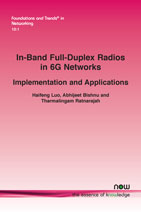In-Band Full-Duplex Radios in 6G Networks: Implementation and Applications
By Haifeng Luo, The University of Edinburgh, UK, h.luo@ieee.org | Abhijeet Bishnu, The University of Edinburgh, UK, abishnu@ieee.org | Tharmalingam Ratnarajah, The University of Edinburgh, UK, T.Ratnarajah@ieee.org
Abstract
Sixth-generation (6G) wireless communication networks will transform connected things in 5G into connected intelligence. The networks can have human-like cognition capabilities by enabling many potential services, such as high-accuracy localization and tracking, augmented human sense, gesture and activity recognition, etc. For this purpose, many emerging applications in 6G have stringent requirements on transmission throughput and latency. With the explosion of devices in the connected intelligence world, spectrum utilization has to be enhanced to meet these stringent requirements. In-band fullduplex (IBFD) has been reported as a promising technique to enhance spectral efficiency and reduce end-to-end latency. However, simultaneous transmission and reception over the same frequency introduce additional interference compared to conventional half-duplex (HD) radios. The receiver is exposed to the transmitter of the same node operating in IBFD mode, causing self-interference (SI), which could be more than 100dB higher than the signal of interest from other nodes due to the proximity of the transceiver. Due to the significant power difference between SI and the signal of interest (SoI), SI must be effectively suppressed to benefit from IBFD operation. In addition to SI, uplink users will interfere with downlink users within the range, known as co-channel Interference (CCI). This interference could be significant in cellular networks, so it has to be appropriately processed to maximize the IBFD gain. The objective of this monograph is to present a timely overview of selfinterference cancellation (SIC) techniques and discuss the challenges and possible solutions to implement effective SIC in 6G networks. Then, we investigate beamforming to manage the complex interference and maximize the IBFD gain in cellular networks. Furthermore, we give a deep insight into the benefits of IBFD operations on various emerging applications, e.g., integrated access and backhaul (IAB) networks, integrated sensing and communications (ISAC), and physical layer security (PLS).
In-Band Full-Duplex Radios in 6G Networks: Implementation and Applications
Sixth-generation (6G) wireless communication networks will transform connected things in 5G into connected intelligence. The networks can have human-like cognition capabilities by enabling many potential services, such as high-accuracy localization and tracking, augmented human sense, gesture and activity recognition, etc. For this purpose, many emerging applications in 6G have stringent requirements on transmission throughput and latency. With the explosion of devices in the connected intelligence world, spectrum utilization has to be enhanced to meet these stringent requirements. In-band full-duplex has been reported as a promising technique to enhance spectral efficiency and reduce end-to-end latency. However, simultaneous transmission and reception over the same frequency introduce additional interference compared to conventional half-duplex radios. The receiver is exposed to the transmitter of the same node operating in in-band full-duplex mode, causing self-interference. Due to the significant power difference between self-interference and the signal of interest, self-interference must be effectively suppressed to benefit from in-band full-duplex operation. In addition to self-interference, uplink users will interfere with downlink users within the range, known as co-channel interference. This interference could be significant in cellular networks, so it has to be appropriately processed to maximize the in-band full-duplex gain.
The objective of this monograph is to present a timely overview of self-interference cancellation techniques and discuss the challenges and possible solutions to implement effective self-interference cancellation in 6G networks. Also included is beamforming to manage the complex interference and maximize the in-band full-duplex gain in cellular networks. Furthermore, a deep insight into the benefits of in-band full-duplex operations on various emerging applications is presented, such as integrated access and backhaul networks, integrated sensing and communications, and physical layer security.
